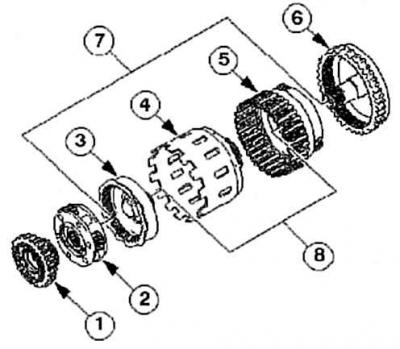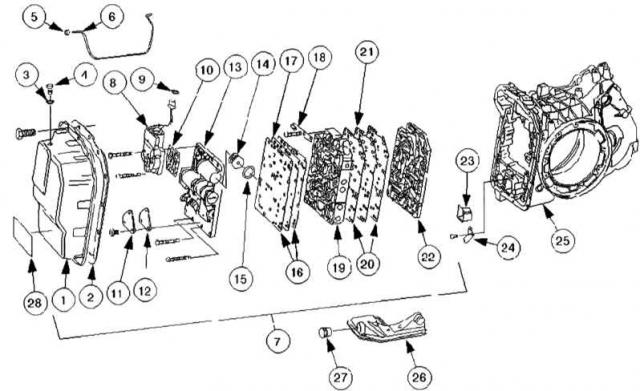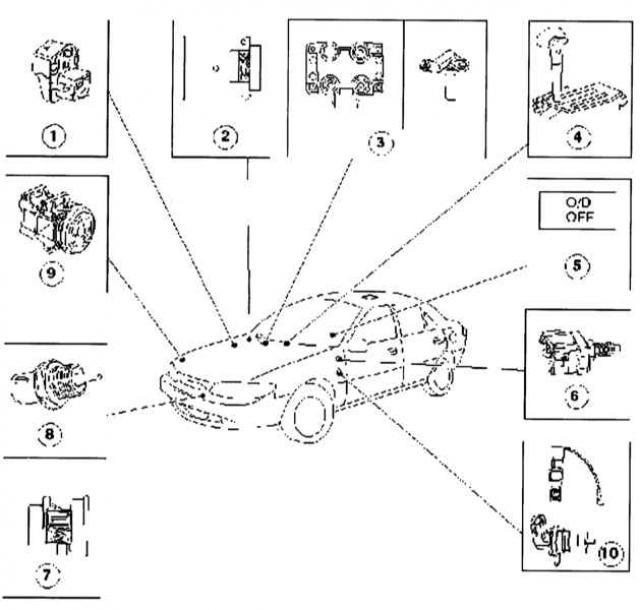Designated CD4E, the transmission is an electronic automatic 4-speed transmission for front-wheel drive vehicles. The CD4E automatic transmission works in conjunction with a torque converter lock-up clutch and a push-button activated accelerator. Two rows of planetary gears connected one after the other implement the corresponding gear ratios - three multi-plate clutches, one multi-plate brake, one brake band and a roller freewheel reproduce the drive and brake functions. The drive torque passes through the intermediate gear cascade before it reaches the final drive.
Shifting without breaking the traction force: planetary gear
 |
|
1 - Sun gear, 1-/2-gear,
|
5 - Planet carrier, reverse / 4th gear,
|
Mondeo automatic transmission - this is how the gear stage shifts
The Mondeo's automatic transmission shifts gear ratio under load - like all automatic transmissions - without breaking tractive power. As «clutch» the machine drives a four-component torque converter with a blocking clutch. Converter input «in Game» the following components:
- planetary gear set
- chain drive,
- planetary gear (main gear),
- bevel and side wheel differential.
It receives its instructions from an electronically controlled hydraulic mechanism.
Six functions can be controlled via the shift lever: P, R, N, D, 2, 1. In addition, the transmission control switch gives you the option to «repayment» accelerator. In second and third gear, the driver of a Mondeo with such a gearbox can also use the action of the engine brake.
Position (R): In this position, no power transmission takes place in the gearbox. The shift shaft lever, which is connected to the camshafts, presses the parking cam on the parking wheel against the driven sprocket. Thanks to this, the main gear is locked and the drive wheels «are blocked». For safety reasons, always set the parking brake when the Mondeo is parked.
Central director's point: steering box for automatic transmission CD4E
 |
|
1 — Cover of a case of the steering mechanism,
|
16 — Laying of the case of the servomechanism (intermediate plate, 2 pieces),
|
Position (R): In this position, you drive with a reduced gear ratio in reverse. The action of the engine brake in position R, however, takes place.
Position (N): as in position P, there is no transmission of forces to the gearbox. However, the main gear does not block the parking cam - thus the wheels can rotate. You can also start your Mondeo in position N.
Position (D): in position D (DRIVE) during normal operation, all switching processes take place automatically (from first to fourth gear) and programs (Clutch engagement and disengagement, interlock clutch, fuel consumption optimization). fourth gear (Overdrive) uses engine brake action and can be locked to the shift lever with the transmission control switch. With Overdrive off (TCIL indicator on) automation uses the action of the engine brake of the second and third gears.
Position (2): Position 2 «blocks» 2nd stage after automatic or manual downshift or upshift. As soon as you preset 2nd gear at a stop, your Mondeo starts off in 2nd gear - an advantage on slippery roads or when there is ice or snow. In position 2, engine brake action is given to second gear.
Position (1): Position 1 represents the first step. To protect the transmission from high speeds, the PCM ignores position 1 above 48 km/h. Of course, in position 1, engine braking torque is also provided - these brakes help save the car when driving in mountainous terrain.
High gear shift: The PCM processes various signals from a variety of sensors and the driver's personal commands to control shift processes, shift pressure and lock-up clutch.
Downshifting: Under certain conditions, the transmission automatically shifts to low range (without using the gear lever). There are three categories for automatic downshifting: forced idle, torque demand, and forced downshifts.
Forced idle mode: Shifting to low gears in the forced idle mode occurs when the car in this mode manually brakes.
Torque requirement: Shifting down to low gears to meet torque requirements is automatic during part load accelerations, once the torque requirement at that gear ratio exceeds the engine's capability, the engaged lock-up cylinder is deactivated to take care of additional acceleration on occasion.
Downshifting (Kickdown): Downshifting for maximum acceleration can be triggered by fully depressing the accelerator - at speeds below 88 km/h in second gear and below 40 km/h Kickdown causes a shift to first gear.
The principle of operation of the control switch of the gearbox and indicator: The accelerator can be turned off using the transmission control switch. The system automatically reactivates the accelerator as soon as the engine is restarted or the transmission control switch is turned on. This is visually manifested by the light bulb on the instrument panel.
Assistants in the background: RSM reacts to them
 |
|
1 - Throttle position sensor (TR),
|
6 - Brake light switch,
|
Automatic transmission repair - no work for an amateur
Modern automatic transmissions are overtaking the call for improved reliability. And this can be said with good reason: since, as practice has shown, their failure, with proper operation, can hardly be caused by excessive wear. In other words: on the machines in the Ford workshops, the appearance of an automatic transmission is very rare. Naturally, there are exceptions to this rule: when such units «badly looked after». As a result, they have to return to the factory for an audit.
Visitor comments